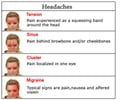A functional magnetic resonance imaging (fMRI) showed for the first time a neurological basis for visual remedies for migraine sufferers with precision tinted lenses.

The new research shows how coloured glasses tuned to each migraine sufferer work by normalizing activity in the brain. The researchers saw specific abnormal brain activity (known as hyperactivation) when migraine sufferers saw intense patterns. The tinted lenses considerably reduced the effect.
Jie Huang along with colleagues from Michigan State University and the University of Michigan, US, and the University of Essex, UK, homed in on specific visual stimuli known to trigger migraines. These patterns, high contrast stripes or 'gratings,' can give the illusion of shape, colour and movement. These not only trigger migraines but also may cause seizures in those with photosensitive epilepsy.
Before the brain imaging took place, participants were tested and prescribed precision ophthalmic tints (POTs) with an Intuitive Colorimeter. Previous studies have suggested that some 42% of migraine with aura sufferers saw their migraine frequency halved on days when they wore POTs. The researchers used the colorimeter to illuminate text with coloured light, manipulating hue and saturation at constant luminance. For each test participant this gave an optimal hue and saturation (chromaticity) of light that led to the greatest comfort, reducing perceptual distortion. The test subjects then viewed stressful striped patterns illuminated with their optimal coloured light settings to screen for efficacy. The researchers used these readings to generate both effective POTs for each migraine sufferer and also two other pairs of grey and coloured lenses with slightly different properties as controls. 11 patients who frequently suffered from migraine enrolled in the fMRI study. Each patient was paired with a migraine-free control, who was also tested with that patient's three sets of lenses.
Once in the fMRI machine, the researchers exposed subjects to a range of striped patterns – these had varying likelihood of triggering distortion and discomfort. This study aimed to investigate the effect of the POTs on the cortical activation induced by the stressful pattern in each of the visual areas of the brain. Although patients reported some relief using all of the lenses (by around 40%), the POT lenses had a significant effect when viewing the stressful stripes (70% discomfort reduction). Both control and migraine patients responded similarly to the non-stressful stripe patterns, and in these cases all three lenses made no difference to the result. The POTs specifically suppressed cortical activation for migraine sufferers in visual area V2 of the occipital cortex of the brain, and this POT-suppressed cortical activation was also extended to the other extra-striate visual areas V3, V3A, and V4
"The reduced cortical activation in V2 by the POTs may have been responsible for the POT-induced suppression of the illusions and distortions, considering that V2 neurons but not V1 neurons in macaque monkeys respond to illusory contour stimuli," Huang suggests.
Advertisement













